SOLIDWORKS is the most widely used MCAD package across the globe and is employed by more designers and engineers than any other. SOLIDWORKS’ dominance boils down to the fact that, compared with other enterprise MCAD programs, it’s easy to use. Another important reason is the development strategy that SOLIDWORKS put in place when it first debuted in 1995.
According to Gabe Enright, a technical marketing specialist at Dassault Systèmes SOLIDWORKS, since its first release, the company has been devoted to creating a robust MCAD tool with a strong application program interface (API). This has allowed for third parties to develop embedded applications that expand the MCAD package’s capabilities via a Partner Product Program.
One excellent example of how this program has bolstered the package’s abilities is the proliferation of Gold-status partners offering full-blown CAM applications.
How Does the Partner Product Program Work?
The SOLIDWORKS Partner Product Program involves three phases, beginning with the “Research Associate” level.
To become a Research Associate, a third-party group must undergo a review with SOLIDWORKS’ partnership program leaders. On the SOLIDWORKS website, there is an online application available for potential partners to submit their intent to join the program, this includes the execution of the Partner Program Agreement which provides terms for use of the SOLIDWORKS licenses for product development. Upon receipt of the completed application, the Partner Program conducts a thorough review of the application, as well as the business. Once approved, a Research Associate will receive a copy of the latest version of SOLIDWORKS software, access to the SOLIDWORKS API and several sources for partnership support. With all of those assets in place, a Research Associates is required to have a functional product developed and released to the market within 24 months.
If a Research Associate team successfully develops an application, they are eligible to become a “Solution Partner.” A Solution Partner is expected to have shipped a SOLIDWORKS-compatible product and possess at least two references who can attest to the value of the product. If those two criteria are met, a Solution Partner will have their product listed in the SOLIDWORKS Partner Directory and receive special SOLIDWORKS marketing opportunities. In addition, all websites and products have the option of being branded with a SOLIDWORKS Solution Partner logo.
The pinnacle of the SOLIDWORKS Partner Product Program is the “Certified Gold Product” status. To attain a Gold label, the third party must have passed through both the Research Associate and Solution Partner levels and have released a fully-integrated and interoperable product. In addition, the applicant must also have five SOLIDWORKS customer references and undergo a software design review by SOLIDWORKS engineers. Similar to the Solution Partners, these applications will be identified by Dassault Systèmes SOLIDWORKS as a Certified Gold Product in the online SOLIDWORKS Partner Directory and will have the option of being branded as such. Finally, Dassault Systèmes SOLIDWORKS will notify all value-added resellers of the product.
The simple fact that Certified Gold Partners are fully integrated with SOLIDWORKS is a big deal. The Partner Program hosts a full range of Certified Gold Products in several categories and domains (e.g. simulation, design, manufacturing, data management, etc.) The CAM domain is one that “lives close” to CAD and there has been a growing demand over the years for seamless user access to CAM. First, full integration means that user workflows are straightforward and make sense within the SOLIDWORKS UI. Furthermore, full integration means that designers don’t have to learn a completely new interface language in order to be productive. By leveraging SOLIDWORKS’ well-crafted UI productivity, CAM learning curves can be optimized, even for users with little or no experience with CAM.
What Gold CAM Applications Are Available?
So, what options are available for SOLIDWORKS users looking to license a Certified Gold or Certified CAM application for SOLIDWORKS? Well, there are many.
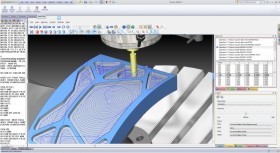
BobCAD’s SOLIDWORKS application offers fully integrated support for 2- to 5-axis milling and turning. BobCAM also includes machining wizards to simplify toolpath creation, an automatic g-code generator, a virtual simulation engine and fully customizable post processors.
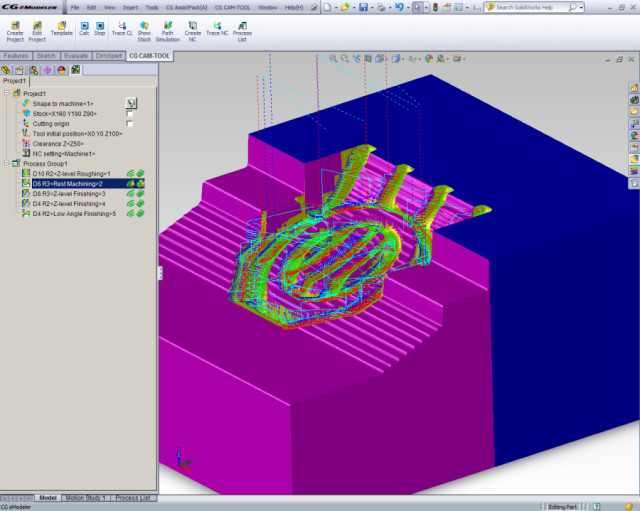
2. CG CAM-TOOL
CG CAM-TOOL boasts a user-friendly interface, high-precision and high-efficiency machining strategies, a mounting tool and holder database and a flexible post processor setting. Although it might not be widely used in the United States, CG CAM-TOOL is the most commonly used CAD/CAM tool in Japan.
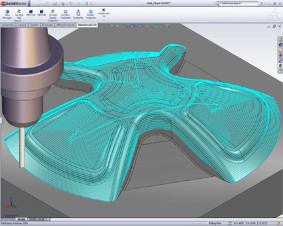
Mastercam’s SOLIDWORKS application is a multi-axis tool that comes with the company’s reliable feature-based machining capabilities, including the ability to automatically program holes, pockets and contours. In addition, Mastercam provides toolpath associativity that stores all toolpath data directly in the source SOLIDWORKS file.
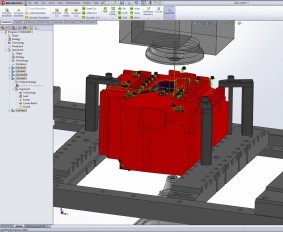
4. OPTICAM
OPTICAM is a highly automated CAM solution that uses feature recognition technology to automate wire EDM machining.
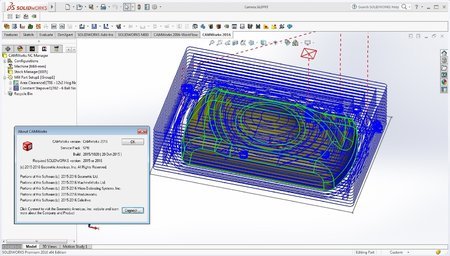
5. CAMWorks
CAMWorks can claim the fact that it is the first fully integrated CAM solution for SOLIDWORKS. Like many advanced CAM products, CAMWorks uses feature-based machining strategies to automate milling and turning processes. It also features high-speed machining strategies to improve milling efficiency.
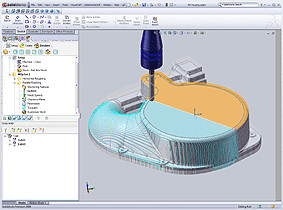
VisualMILL prides itself on being an affordable CAM solution that provides support for 2.5- to 5-axis mill programming. In addition to its relatively low price, the software also comes complete with free post processors, thereby simplifying g-code translation for multi-machine operations.
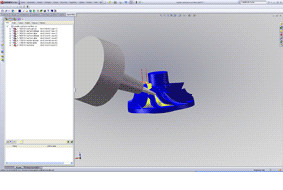
hyperMILL is a multiaxis machining platform that comes equipped with hole and pocket feature recognition technology. With its ability to program both milling and turning strategies in a single operation, hyperMILL is used across a number of high-performance engineering industries—including the mold, automotive and aerospace sectors—throughout Asia, Europe and North America.
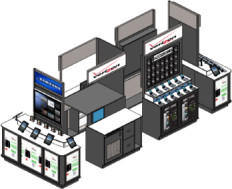
8. PathFinder3D
PathFinder3D is unique among SOLIDWORKS Gold CAM solutions. Unlike other applications, PathFinder3D has carved out a space in the custom cabinetry, furniture, luxury yacht and motor home markets in which CAM is used. PathFinder3D includes advanced feature recognition tools and the ability to automatically update tool paths as models are reconfigured in SOLIDWORKS.
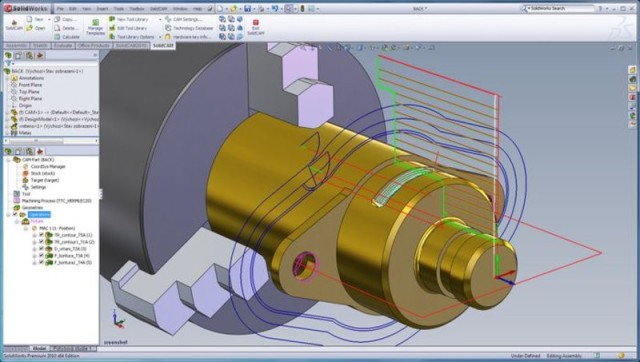
9. SolidCAM
SolidCAM is a multi-axis CAM tool featuring a “Technology Wizard” that can guide users through a milling project to optimize production. With the ability to run anywhere from two to three times faster and deeper than other CAM products, SolidCAM has prided itself on developing state-of-the-art milling techniques. In addition, SolidCAM offers a complete CAM simulation package that includes visualization of parts, stocks, tooling, cutters and even the machine that will execute the work.
***
The SOLIDWORKS Partner Product Program has been a huge boon for the MCAD leader, giving users multiple options for an integrated CAM solution. Not only has it added expanded abilities to the software package, it’s also helped the SOLIDWORKS development team stay focused on their core product, a robust MCAD modeler.
Even so, it’s becoming more obvious that the CAD industry as a whole is moving toward integrated CAD-CAM solutions as the standard model for digital manufacturing suites, and that’s excellent news for everyone. With integrated CAD-CAM solutions, designers won’t have to worry about buying multiple licenses for two separate CAD and CAM solutions. What’s more, there won’t be disconnects between incompatible files. The most important aspect of this CAD-CAM union, however, might be the fact that companies will be able to rely on their designers to adopt roles as CAM engineers while saving time and money on projects.
About the Author
Kyle Maxey is a mechanical designer and writer from Austin, TX. He earned a degree in Film at Bard College and has since studied Mechanical and Architectural drafting at Austin Community College. As a designer Kyle has had vast experience with CAD software and rapid prototyping. One day he dreams of becoming a toy designer.

